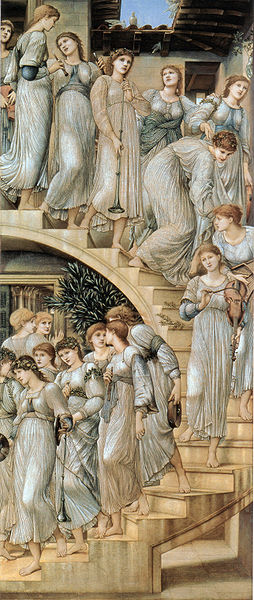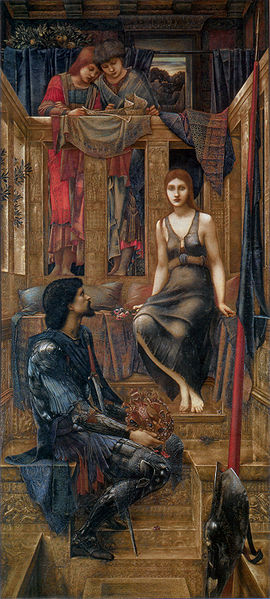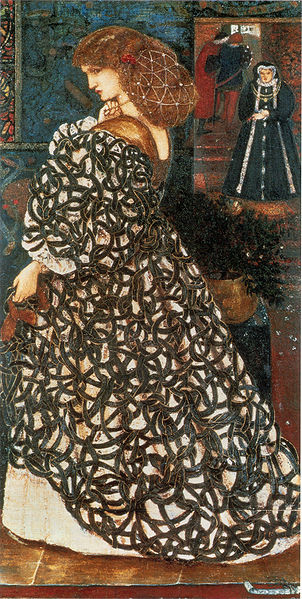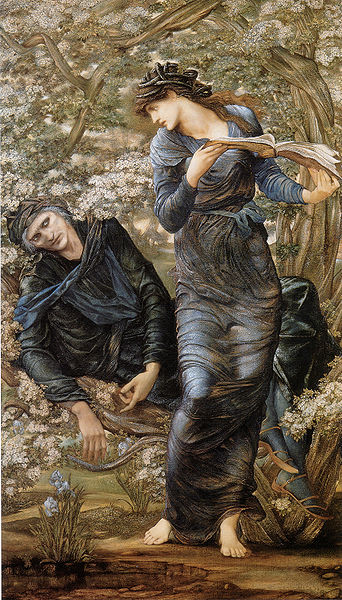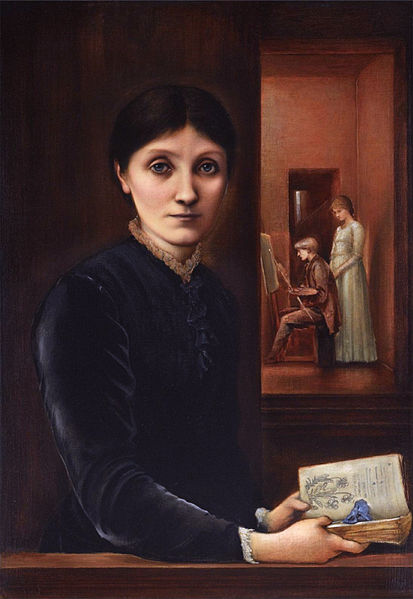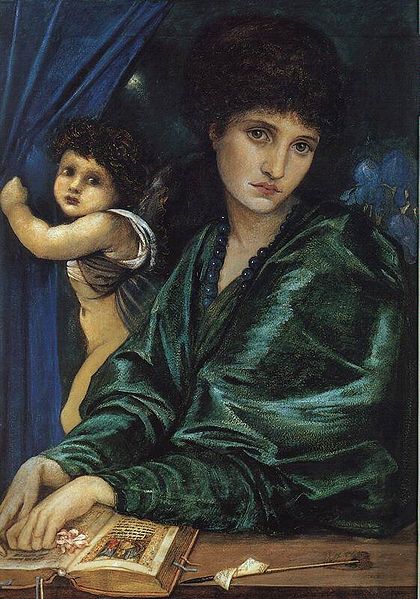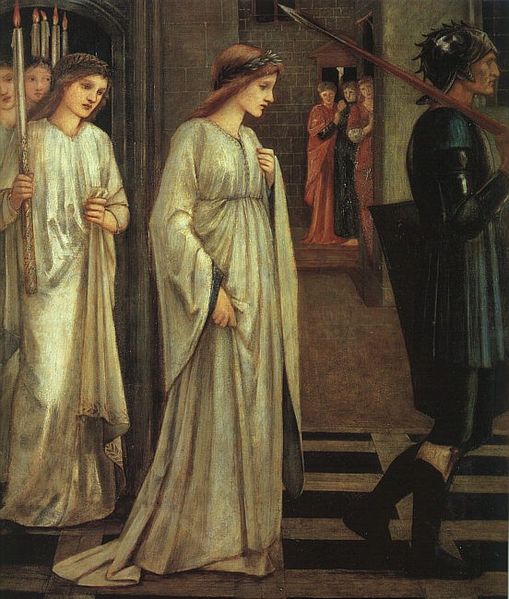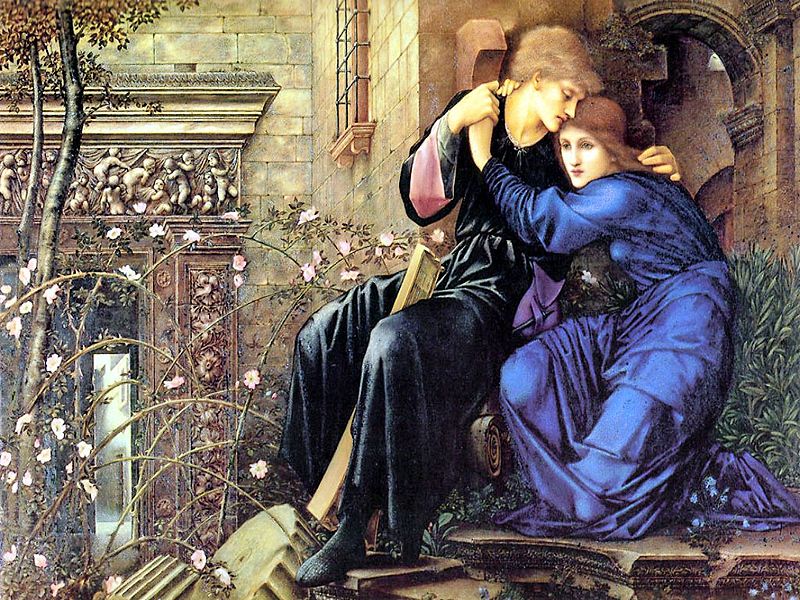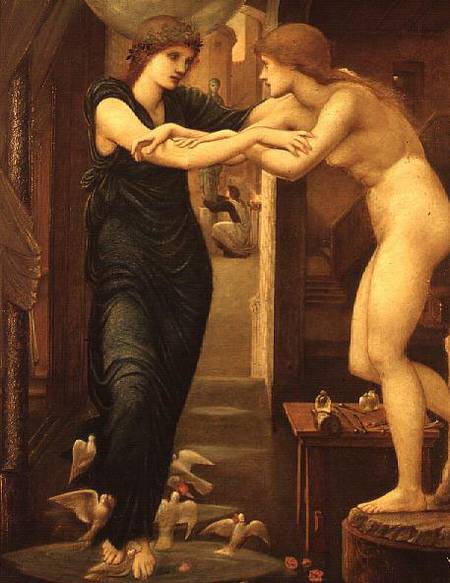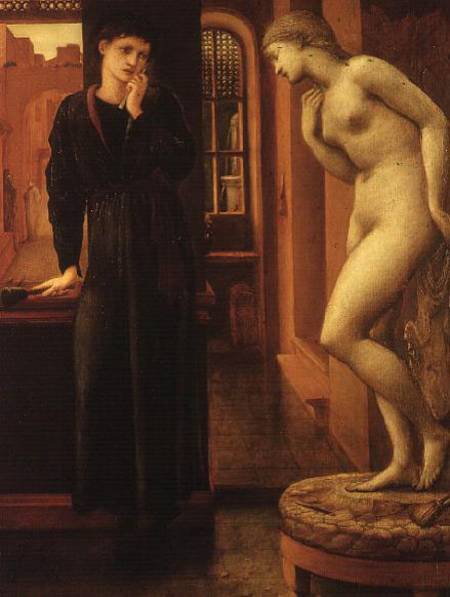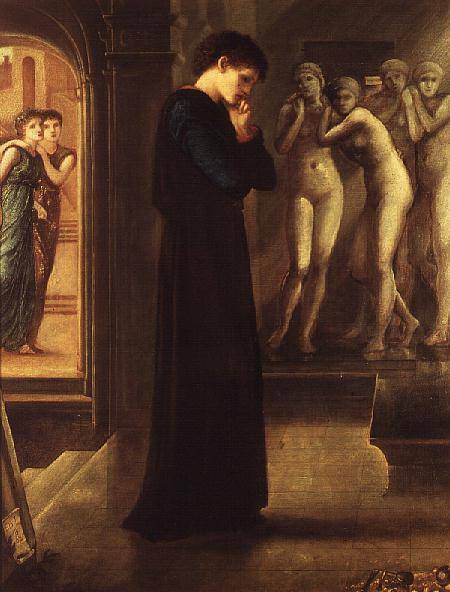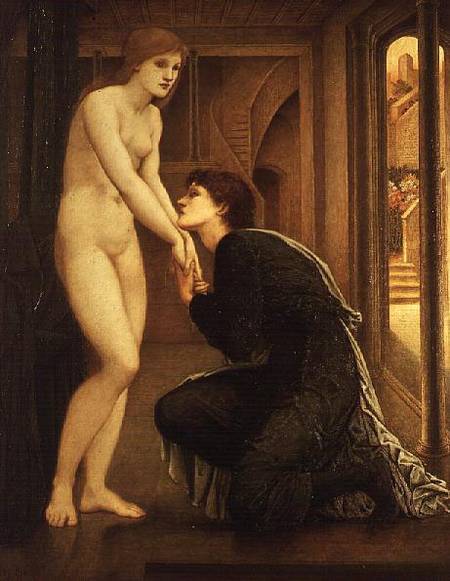<Back to Index>
- Economist Antoine Augustin Cournot, 1801
- Painter Edward Coley Burne - Jones, 1833
- 1st Duke of Buckingham George Villiers, 1592
PAGE SPONSOR
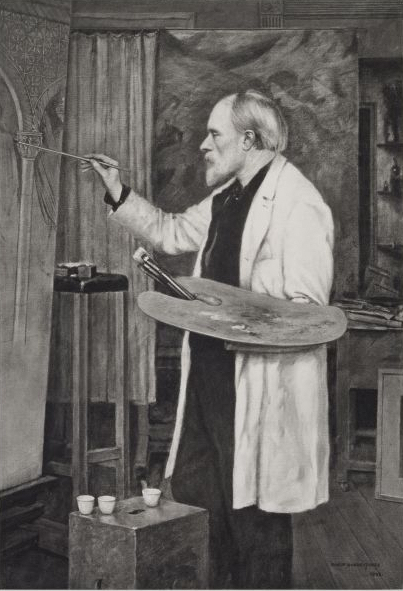
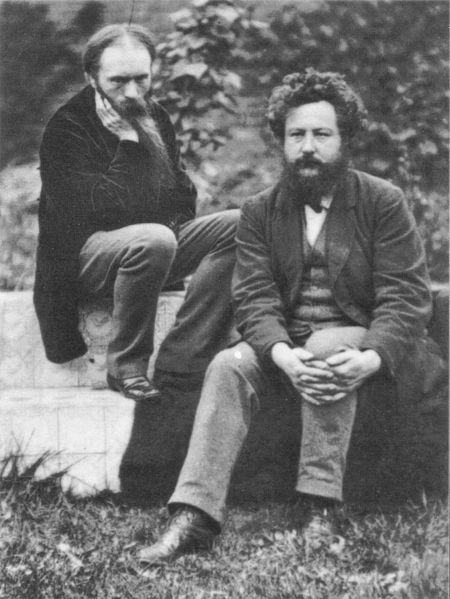
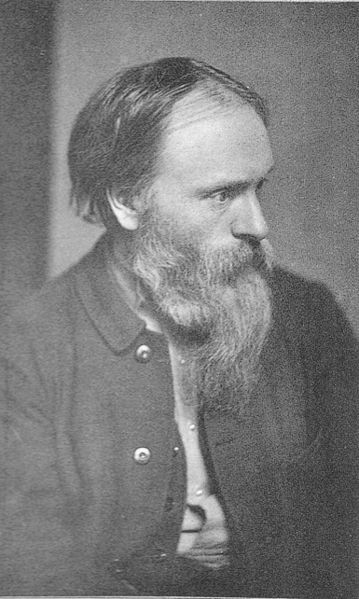
Sir Edward Coley Burne-Jones, 1st Baronet (28 August 1833 – 17 June 1898) was a British artist and designer closely associated with the later phase of the Pre-Raphaelite movement, who worked closely with William Morris on a wide range of decorative arts as a founding partner in Morris, Marshall, Faulkner, and Company. Burne-Jones was closely involved in the rejuvenation of the tradition of stained glass art in England; his stained glass works include the windows of St. Philip's Cathedral, Birmingham, St Martin's Church in Brampton, Cumbria, the church designed by Philip Webb, All Saints, Jesus Lane, Cambridge, and in Christ Church, Oxford.
Burne-Jones's early paintings show the heavy inspiration of Dante Gabriel Rossetti,
but by the 1860s Burne-Jones was discovering his own artistic "voice".
In 1877, he was persuaded to show eight oil paintings at the Grosvenor Gallery (a new rival to the Royal Academy). These included The Beguiling of Merlin. The timing was right, and he was taken up as a herald and star of the new Aesthetic Movement. In addition to painting and stained glass, Burne-Jones worked in a variety of crafts; including designing ceramic tiles, jewellery, tapestries, mosaics and book illustration, most famously designing woodcuts for the Kelmscott Press's Chaucer in 1896. Edward Coley Burne Jones (the hyphen came later) was born in Birmingham, the son of a Welshman, Edward Richard Jones, a frame maker at Bennetts Hill, where a blue plaque commemorates
the painter's childhood. His mother Elizabeth Coley Jones died within
six days of his birth, and he was raised by his grieving father and the
family housekeeper, Ann Sampson, an obsessively affectionate but
humorless and unintellectual local girl. He attended Birmingham's King Edward VI grammar school from 1844 and the Birmingham School of Art from 1848 to 1852, before studying theology at Exeter College, Oxford. At Oxford he became a friend of William Morris as a consequence of a mutual interest in poetry. The two Exeter undergraduates, together with a small group of Birmingham men at Pembroke College and
elsewhere, speedily formed a very close and intimate society, which
they called "The Brotherhood". The members of the Brotherhood read John Ruskin and Tennyson, visited churches, and worshipped the Middle Ages. At this time Burne-Jones discovered Thomas Malory's Le Morte d'Arthur which
was to be so influential in his life. At that time neither Burne -
Jones nor Morris knew Rossetti personally, but both were much
influenced by
his works, and met him by recruiting him as a contributor to their Oxford and Cambridge Magazine which Morris founded in 1856 to promote their ideas. Burne-Jones
had intended to become a church minister, but under Rossetti's
influence both he and Morris decided to become artists, and Burne - Jones
left college before taking a degree to pursue a career in art. In
February 1857, Rossetti wrote to William Bell Scott Two young men, projectors of the Oxford and Cambridge Magazine, have
recently come up to town from Oxford, and are now very intimate friends
of mine. Their names are Morris and Jones. They have turned artists
instead of taking up any other career to which the university generally
leads, and both are men of real genius. Jones's designs are marvels of
finish and imaginative detail, unequalled by anything unless perhaps Albert Dürer's finest works. Burne-Jones'
early work was heavily influenced by his mentor Rossetti, but he later
developed his own style influenced by his travels in Italy with Ruskin
and others. In 1856 Burne-Jones became engaged to Georgiana "Georgie" MacDonald (1840 – 1920), one of the MacDonald sisters. She was training to be a painter, and was the sister of Burne-Jones's old school friend. The couple married in 1860, after which she made her own work in woodcuts and became a close friend of George Eliot. (Another MacDonald sister married the artist Sir Edward Poynter, a further sister married the ironmaster Alfred Baldwin and was the mother of the Prime Minister Stanley Baldwin, and yet another sister was the mother of Rudyard Kipling. Kipling and Baldwin were thus Burne-Jones's nephews). Georgiana bore a son, Philip,
in 1861. A second son, born in the winter of 1864 while Georgiana was
gravely ill with scarlet fever, died soon after birth. The family soon
moved to 41 Kensington Square, and their daughter Margaret was born
there in 1866. In 1867 Burne-Jones and his family settled at the Grange, an 18th century house set in a large garden in North End Road, Fulham,
London. For much of the 1870s Burne-Jones did not exhibit, following a
spate of bitterly hostile attacks in the press, and a passionate affair
(described as the "emotional climax of his life") with his Greek model Maria Zambaco which ended with her trying to commit suicide by throwing herself in Regent's Canal. During these difficult years Georgiana developed a close friendship with Morris, whose wife Jane had
fallen in love with Rossetti. Morris and Georgie may have been in love,
but if he asked her to leave her husband, she refused. In the end, the
Burne-Joneses remained together, as did the Morrises, but Morris and
Georgiana were close for the rest of their lives. In 1880 the Burne-Joneses bought Prospect House in Rottingdean, near Brighton in Sussex, as their holiday home, and soon after the next door Aubrey Cottage to create North End House, reflecting the fact that their Fulham home was in North End Road. (Years later, in 1923, Sir Roderick Jones, head of Reuters, and his wife, playwright and novelist Enid Bagnold, were to add the adjacent Gothic House to the property and which became the inspiration and setting for her play The Chalk Garden). His troubled son Philip became a successful portrait painter and died in 1926. His adored daughter Margaret (died 1953) married John William Mackail (1850 – 1945),
the friend and biographer of Morris, and Professor of Poetry at Oxford
from 1911 – 1916. Their children were the novelists Angela Thirkell and Denis Mackail. Burne-Jones
once admitted that after leaving Oxford he "found himself at five - and
- twenty what he ought to have been at fifteen." He had had no regular training as a draughtsman, and lacked the confidence
of science. But his extraordinary faculty of invention as a designer
was already ripening; his mind, rich in knowledge of classical story
and medieval romance, teemed with pictorial subjects; and he set
himself to complete his equipment by resolute labour, witnessed by
innumerable drawings. The works of this first period are all more or
less tinged by the influence of Rossetti; but they are already
differentiated from the elder master's style by their more facile
though less intensely felt elaboration of imaginative detail. Many are
pen-and-ink drawings on vellum, exquisitely finished, of which 1856's Waxen Image is
one of the earliest and best examples. Although subject, medium and
manner derive from Rossetti's inspiration, it is not the hand of a
pupil merely, but of a potential master. This was recognized by
Rossetti himself, who before long avowed that he had nothing more to
teach him. Burne-Jones's first sketch in oils dates from this same
year, 1856; and during 1857 he made for Bradfield College the first of what was to be an immense series of cartoons for stained glass. In 1858 he decorated a cabinet with the Prioress's Tale from Geoffrey Chaucer's Canterbury Tales,
his first direct illustration of the work of a poet whom he especially
loved and who inspired him with endless subjects. Thus early,
therefore, we see the artist busy in all the various fields in which he
was to labour. In the autumn of 1857 Burne-Jones joined Morris, Valentine Prinsep, J.R. Spencer Stanhope and others in Rossetti's ill-fated scheme to decorate the walls of the Oxford Union. None of the painters had mastered the technique of fresco,
and their pictures had begun to peel from the walls before they were
completed. In 1859 Burne-Jones made his first journey to Italy. He saw Florence, Pisa, Siena, Venice and
other places, and appears to have found the gentle and romantic Sienese
more attractive than any other school. Rossetti's influence still
persisted, and is visible, more strongly perhaps than ever before, in
the two watercolours of 1860, Sidonia von Bork and Clara von Bork. Both paintings illustrate the 1849 gothic novel Sidonia the Sorceress by Lady Wilde, a translation of Sidonia Von Bork: Die Klosterhexe (1847) by Johann Wilhelm Meinhold. In 1861, William Morris founded the decorative arts firm of Morris, Marshall, Faulkner & Co. with Rossetti, Burne-Jones, Ford Madox Brown and Philip Webb as partners, together with Charles Faulkner and Peter Paul Marshall, the former of whom was a member of the Oxford Brotherhood, and the latter a friend of Brown and Rossetti. The prospectus set forth that the firm would undertake carving, stained glass, metal-work, paper-hangings, chintzes (printed fabrics), and carpets. The decoration of churches was from the first an important part of the business. The work shown by the firm at the 1862 International Exhibition attracted
much notice, and within a few years it was flourishing. Two significant
secular commissions helped establish the firm's reputation in the late
1860s: a royal project at St. James's Palace and the "green dining room" at the South Kensington Museum (now the Victoria and Albert) of 1867 which featured stained glass windows and panel figures by Burne-Jones. In 1871 Morris & Co. were responsible for the windows at All Saints, designed by Burne-Jones for Alfred Baldwin,
his wife's brother - in - law. The firm was reorganized as Morris & Co.
in 1875, and Burne-Jones continued to contribute designs for stained
glass, and later tapestries until the end of his career. Stained glass
windows in the Christ Church cathedral and other buildings in Oxford are by William Morris & Co. with designs by Burne-Jones. Stanmore
Hall was the last major decorating commission executed by Morris &
Co. before Morris's death in 1896. It was also the most extensive
commission undertaken by the firm, and included a series of tapestries based on the story of the Holy Grail for the dining room, with figures by Burne-Jones. In 1864 Burne-Jones was elected an associate of the Society of Painters in Water-Colours (also known as the Old Water-Colour Society), and exhibited, among other works, The Merciful Knight, the
first picture which fully revealed his ripened personality as an
artist. The next six years saw a series of fine watercolours at the
same gallery; but in 1870, Burne-Jones resigned his membership following a controversy over his painting Phyllis and Demophoön.
The features of Maria Zambaco were clearly recognizable in the
barely draped Phyllis (as they are in several of Burne-Jones's finest
works), and the undraped nakedness of Demophoön coupled with the
suggestion of female sexual assertiveness offended Victorian sensibilities.
Burne-Jones was asked to make a slight alteration, but instead
"withdrew not only the picture from the walls, but himself from the
Society." During
the next seven years, 1870 – 1877, only two works of the painter's were
exhibited. These were two water-colours, shown at the Dudley Gallery in 1873, one of them being the beautiful Love among the Ruins, destroyed
twenty years later by a cleaner who supposed it to be an oil painting,
but afterwards reproduced in oils by the painter. This silent period
was, however, one of unremitting production. Hitherto Burne-Jones had
worked almost entirely in water-colours. He now began a number of large
pictures in oils, working at them in turn, and having always several on
hand. The first Briar Rose series, Laus Veneris, the Golden Stairs, the Pygmalion series, and The Mirror of Venus are among the works planned and completed, or carried far towards completion, during these years. These years also mark the beginnings of Burne-Jones's partnership with the fine-art photographer Frederick Hollyer,
whose reproductions of paintings and — especially — drawings would expose a
wider audience to Burne-Jones's works in the coming decades. At last, in May 1877, the day of recognition came, with the opening of the first exhibition of the Grosvenor Gallery, when the Days of Creation, The Beguiling of Merlin, and the Mirror of Venus were all shown. Burne-Jones followed up the signal success of these pictures with Laus Veneris, the Chant d'Amour, Pan and Psyche, and
other works, exhibited in 1878. Most of these pictures are painted in
brilliant colours. A change is noticeable next year, 1879, in the Annunciation and in the four pictures making up the second series of Pygmalion and the Image;
the former of these, one of the simplest and most perfect of the
artist's works, is subdued and sober; in the latter a scheme of soft
and delicate tints was attempted, not with entire success. A similar
temperance of colours marks The Golden Stairs, first exhibited in 1880. The almost sombre Wheel of Fortune was shown in 1883, followed in 1884 by King Cophetua and the Beggar Maid, in
which Burne-Jones once more indulged his love of gorgeous colour,
refined by the period of self-restraint. He next turned to two
important sets of pictures, The Briar Rose and The Story of Perseus, though these were not completed for some years to come. Burne-Jones was elected an Associate of the Royal Academy in 1885, and the following year he exhibited (for the only time) at the Academy, showing The Depths of the Sea, a
painting of a mermaid carrying down with her a youth whom she has
unconsciously drowned in the impetuosity of her love. This picture adds
to the habitual haunting charm a tragic irony of conception and a
felicity of execution which give it a place apart among Burne-Jones's
works. He formally resigned his Associateship in 1893. One of the Perseus series was exhibited in 1887, two more in 1888, with The Brazen Tower, inspired by the same legend. In 1890 the second series of The Legend of Briar Rose were exhibited by themselves, and won the widest admiration. The huge tempera picture, The Star of Bethlehem, painted
for the corporation of Birmingham, was exhibited in 1891. A long
illness for some time checked the painter's activity, which, when
resumed, was much occupied with decorative schemes. An exhibition of
his work was held at the New Gallery in
the winter of 1892 - 1893. To this period belong several of his
comparatively few portraits. In 1894 Burne-Jones was made a baronet.
Ill-health again interrupted the progress of his works, chief among
which was the vast Arthur in Avalon.
In the winter following his death a second exhibition of his works was
held at the New Gallery, and an exhibition of his drawings (including
some of the charmingly humorous sketches made for children) at the Burlington Fine Arts Club.
In 1894, theatrical manager and actor Henry Irving commissioned Burne-Jones to design sets and costumes for the Lyceum Theatre production of King Arthur by J. Comyns Carr,
who was Burne-Jones's patron and the director of the New Gallery as
well as a playwright. The play starred Irving as King Arthur and Ellen Terry as Guinevere, and toured America following its London run. Burne-Jones accepted the commission with some enthuisiasm, but was disapppointed
with much of the final result. He wrote confidentially to his friend Mrs Gaskell "The
armour is good — they have taken pains with it ... Perceval looked the
one romantic thing in it ... I hate the stage, don't tell — but I
do — don't tell but I do don't tell..." Burne-Jones's paintings were one strand in the evolving tapestry of Aestheticism from
the 1860s through the 1880s, which considered that art should be valued
as an object of beauty engendering a sensual response, rather than for
the story or moral implicit in the subject matter. In many ways this
was antithetical to the ideals of Ruskin and the early Pre-Raphaelites. Burne - Jones's aim in art is best given in some of his own words, written to a friend: I
mean by a picture a beautiful, romantic dream of something that never
was, never will be - in a light better than any light that ever shone -
in a land no one can define or remember, only desire - and the forms
divinely beautiful - and then I wake up, with the waking of Brynhild. No
artist was ever more true to his aim. Ideals resolutely pursued are apt
to provoke the resentment of the world, and Burne-Jones encountered,
endured and conquered an extraordinary amount of angry criticism.
Insofar as this was directed against the lack of realism in his
pictures, it was beside the point. The earth, the sky, the rocks, the
trees, the men and women of Burne-Jones are not those of this world;
but they are themselves a world, consistent with itself, and having
therefore its own reality. Charged with the beauty and with the
strangeness of dreams, it has nothing of a dream's incoherence. Yet it
is a dreamer always whose nature penetrates these works, a nature out
of sympathy with struggle and strenuous action. Burne-Jones's men and
women are dreamers too. It was this which, more than anything else,
estranged him from the age into which he was born. But he had an inbred
"revolt from fact" which would have estranged him from the actualities
of any age. That criticism seems to be more justified which has found
in him a lack of such victorious energy and mastery over his materials
as would have enabled him to carry out his conceptions in their
original intensity. Yet Burne-Jones was singularly strenuous in
production. His industry was inexhaustible, and needed to be, if it was
to keep pace with the constant pressure of his ideas. Whatever faults
his paintings may have, they have always the fundamental virtue of
design; they are always pictures. His designs were informed with a mind
of romantic temper, apt in the discovery of beautiful subjects, and
impassioned with a delight in pure and variegated colour. In 1881 Burne-Jones received an honorary degree from Oxford, and was made an Honorary Fellow in 1882. In 1885 he became the President of the Birmingham Society of Artists. At about that time he began hyphenating his name, merely — as he wrote later — to avoid "annihilation" in the mass of Joneses. In November 1893, he was approached to see if he would accept a Baronetcy on the recommendation of the outgoing Prime Minister William Ewart Gladstone, the following February he legally changed his name to Burne-Jones. He was formally created a baronet of Rottingdean, in the county of Sussex, and of the Grange, in the parish of Fulham, in the county of London in the baronetage of the United Kingdom on 3 May 1894, but
remained unhappy about accepting the honour, which disgusted his
socialist friend Morris and was scorned by his equally socialist wife
Georgiana. Only his son Philip, who mixed with the set of the Prince of Wales and would inherit the title, truly wanted it. Morris
died in 1896, and the devastated Burne-Jones's health declined
substantially. In 1898 he had an attack of influenza, and had
apparently recovered, when he was again taken suddenly ill, and died on
17 June 1898. Six days later, at the intervention of the Prince of Wales, a memorial service was held at Westminster Abbey. It was the first time an artist had been so honoured. Burne - Jones was buried in the churchyard at St Margaret's Church, Rottingdean, a place he knew through summer family holidays. Burne-Jones exerted a considerable influence on British painting. Burne-Jones was also highly influential among French symbolist painters, from 1889. His work inspired poetry by Swinburne — Swinburne's 1886 Poems & Ballads is dedicated to Burne-Jones. Two of Burne-Jones's studio assistants, T.M. Rooke and Charles Fairfax Murray, went on to a successful art careers as painters in their own right. Murray later became an important collector and respected art dealer. Between 1903 and 1907 he sold a great many works by Burne-Jones and the Pre-Raphaelites to the Birmingham Museum and Art Gallery,
at far below their market worth. Birmingham Museum and Art Gallery now
has the largest collection of works by Burne-Jones in the world,
including the massive watercolour Star of Bethlehem, commissioned for the Gallery in 1897. The paintings are believed by some to have influenced the young J.R.R. Tolkien, then growing up in Birmingham. Burne-Jones was also a very strong influence on the Birmingham Group of artists, from the 1890s onwards. On 16 June 1933, Prime Minister Stanley Baldwin, a nephew of Burne-Jones, officially opened the centenary exhibition featuring Burne - Jones's drawings and paintings at the Tate Gallery in London. In his opening speech at the exhibition, Mr Baldwin expressed what the art of Burne-Jones stood for: In
my view, what he did for us common people was to open, as never had
been opened before, magic casements of a land of faery in which he
lived throughout his life ... It is in that inner world we can cherish
in peace, beauty which he has left us and in which there is peace at
least for ourselves. The few of us who knew him and loved him well,
always keep him in our hearts, but his work will go on long after we
have passed away. It may give its message in one generation to a few or
in other to many more, but there it will be for ever for those who seek
in their generation, for beauty and for those who can recognise and
reverence a great man, and a great artist. But
in fact, long before 1933, Burne-Jones was hopelessly out-of-fashion in
the art world, much of which soon preferred the major trends in Modern art, and the exhibit marking the 100th anniversary of his birth was a sad affair, poorly attended. It was not until the mid 1970s that his work began to be re-assessed and once again acclaimed. A major exhibit in 1989 at the Barbican Art Gallery, London (in book form as: John Christian, The Last Romantics, 1989) traced Burne - Jones's influence on the next generation of artists, and another at Tate Britain in 1997 explored the links between British Aestheticism and Symbolism. A second lavish centenary exhibit — this time marking the 100th anniversary of Burne-Jones's death — was held at the Metropolitan Museum of Art in New York in 1998, before traveling to the Birmingham Museum and Art Gallery and the Musée d'Orsay, Paris. Fiona MacCarthy in
a review of Burne-Jones's legacy notes that he was "a painter who,
while quintessentially Victorian, leads us forward to the psychological
and sexual introspection of the early twentieth century."
